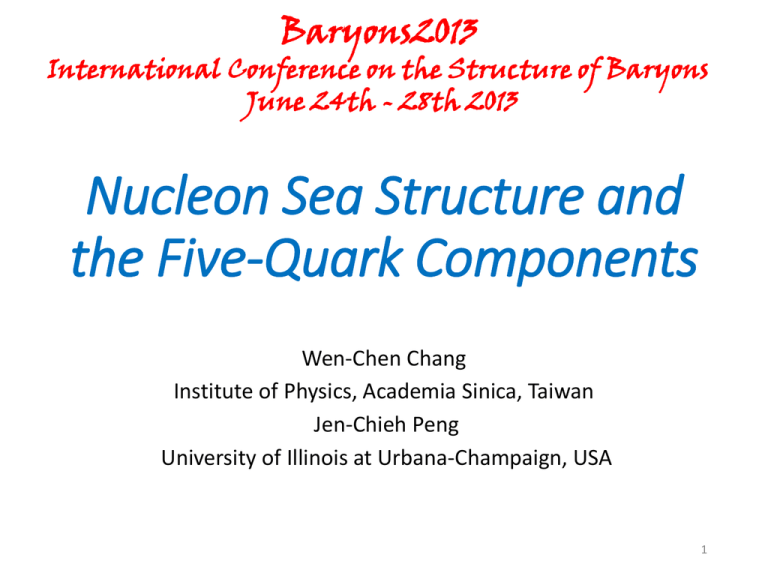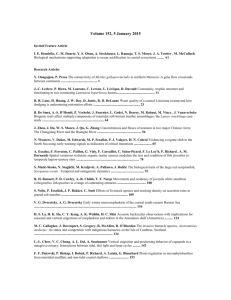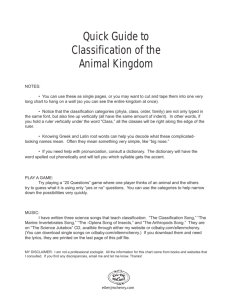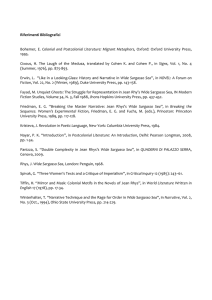Chang - Nuclear Physics
advertisement

Baryons2013 International Conference on the Structure of Baryons June 24th - 28th 2013 Nucleon Sea Structure and the Five-Quark Components Wen-Chen Chang Institute of Physics, Academia Sinica, Taiwan Jen-Chieh Peng University of Illinois at Urbana-Champaign, USA 1 Outline • Evidences of nucleon sea • Flavor Asymmetry of light sea quarks • Structure of strange quarks • Intrinsic sea quarks in light-front 5q model • Sea quarks in lattice-QCD • Prospect • Conclusion 2 Deep Inelastic Scattering Q2 :Four-momentum transfer x : Bjorken variable (=Q2/2Mn) n : Energy transfer M : Nucleon mass W : Final state hadronic mass d 2 Mott [W2 (n , Q 2 ) 2W1 (n , Q 2 ) * tan 2 ( / 2)] ' d dE Mott [ F2 ( x, Q 2 ) / n 2 F1 ( x, Q 2 ) / M * tan 2 ( / 2)] •Scaling •Valence quarks •Quark-antiquark pairs 3 Sum Rules N : expectation value of number of quarks. J.I. Friedman, Rev. Mod. Phys. Vol. 63, 615 (1991) 4 Gottfried Sum Rule SG I 2p I 2n 1 [( F2p ( x ) F2n ( x )) / x ] dx 0 1 1 2 1 p p p dx (uv d v ) (u ( x ) d p ( x )) dx 3 0 3 0 1 (if u p d p ) 3 J.I. Friedman, Rev. Mod. Phys. Vol. 63, 615 (1991) Assume a symmetric quark-antiquark sea, GSR is only sensitive to valance quarks. 5 Gottfried Sum Measured by NMC SG is significantly lower than 1/3 ! SG = 0.235 ± 0.026 New Muon Collaboration (NMC), Phys. Rev. D50 (1994) R1 6 Explanations for the NMC result • Uncertain extrapolation for 0.0 < x < 0.004 • Charge symmetry violation (un d p, dn u p ) • u ( x) d ( x) in the proton 1 (d ( x) u ( x)) dx 0.148 0.04 0 Need independent methods to check the d u asymmetry, and to measure its x-dependence ! 7 Drell-Yan Process Acceptance in Fixed-target Exps. d 4 2 1 2 e [q( xt )q( xb ) q( xt )q( xb )] dxbdxt 9 xb xt s pd |x pp 2 b x t d ( xb ) 1 1 4u( xb ) d ( xt ) 1 d ( xt ) 1 1 2 d ( xb ) d ( xt ) u( xt ) 2 u( xt ) 1 4u ( x ) u ( x ) b t 8 Light Anti-quark Flavor Asymmetry Naïve Assumption: NMC (Gottfried Sum Rule) NA51 (Drell-Yan, 1994) NA 51 Drell-Yan confirms d(x) >u(x) 9 Light Anti-quark Flavor Asymmetry Naïve Assumption: NMC (Gottfried Sum Rule) NA51 (Drell-Yan, 1994) E866/NuSea (Drell-Yan, 1998) 10 Origin of u(x)d(x): Perturbative QCD effect? 𝑞 G 𝑞 • Pauli blocking • guu is more suppressed than gdd in the proton since p=uud (Field and Feynman 1977) • pQCD calculation (Ross, Sachrajda 1979) • Bag model calculation (Signal, Thomas, Schreiber 1991) • Chiral quark-soliton model (Pobylitsa et al. 1999) • Instanton model (Dorokhov, Kochelev 1993) • Statistical model (Bourrely et al. 1995; Bhalerao 1996) • Balance model (Zhang, Ma 2001) The valence quarks affect the gluon splitting. 11 Origin of u(x)d(x): Non-perturbative QCD effect? • Meson cloud in the nucleons (Thomas 1983, Kumano 1991): Sullivan process in DIS. p N ; : 0 : 2 :1: 0 n • Chiral quark model (Eichten et al. 1992; Wakamatsu 1992): Goldstone bosons couple to valence quarks. q q ; : 0 : 4 : 3 : 2 Pion cloud is a source of antiquarks in the protons and it lead to d>u. 12 d ( x) u ( x) vs. Theoretical Models 13 Strange Quark in the Nucleon: Deep-Inelastic Neutrino Scattering n s c X ; c s n n s c X ; c s n 14 Strange Quark in the Nucleon (s s ) 0.5 * (u d ) s( x) s ( x) CCFR, Z. Phys. C 65, 189 (1995) 15 Strange Quark Asymmetry NuTeV, PRL 99, 192001 (2007) Q 2 16 GeV 2 16 s(x)=s(x)? • Meson Cloud Model (Signal and Thomas, 1987) s( x ) s ( x ) at large x • Chiral Field (Burkardt and Warr , 1992) s( x ) s ( x ) at large x • Baryon-Meson Fluctuation (Brodsky and Ma , 1996) s( x ) s ( x ) at large x • Perturbative evolution (Catani et al., 2004) s( x ) s ( x ) at large x 17 Strange Content from Semi-Inclusive Charged-Kaon DIS Production ( s ( x) s ( x)) (u ( x) d ( x)) Restoration of SU(3) symmetry Q 2 2.5 GeV 2 HERMES, PLB 666, 446 (2008) 18 W and Z production at LHC ATLAS, PRL 109, 012001 (2012) 0.5( s s ) rs 1.000.25 0.28 d 19 Parton Distribution Functions of Protons 20 Short Range Structure of Hadron Extrinsic Sea Intrinsic Sea Gluon splitting in leading twist Gluon fusion & light quark scattering (higher-twist) Perturbative radiation Non-perturbative dynamics CP invariant Possible CP non-invariant Fast fluctuation With a longer lifetime Of small x Of large x (valence-like) Strong Q2 dependent Small Q2 dependent Hoyer and Brodsky, AIP Conf. Proc. 221, 238 (1990) 21 Intrinsic Sea Quarks in Light-Front 5q Fock States Brodsky, Hoyer, Peterson, Sakai (BHPS) PLB 93,451 (1980); PRD 23, 2745 (1981) | p P3q | uud P5 q | uudQQ mi2 2 P( x1 ,..., x5 ) N 5 (1 xi ) / [ m ] i 1 i 1 xi 5 5 2 p The "intrinsic"-charm from | uudcc is "valence"-like and peak at large x unlike the "extrinsic" sea (g cc ) “extrinsic” “intrinsic” The | uudcc intrinsic-charm can lead to large contribution to charm production at large x 22 Experimental Evidences of Intrinsic Charm Gunion and Vogt, hep-ph/9706252 23 Global Fit by CTEQ Pumplin, Lai, Tung, PRD 75, 054029 (2007) No Conclusive Evidence….. 24 Search for the lighter “intrinsic” quark sea | p P3q | uud P5q | uudQQ No conclusive experimental evidence for intrinsic-charm so far Are there experimental evidences for the intrinsic | uuduu , | uuddd , | uudss 5-quark states ? 2 Q P5q ~ 1 / m The 5-quark states for lighter quarks have larger probabilities! 25 How to separate the “intrinsic sea” from the “extrinsic sea”? • Select experimental observables which have no contributions from the “extrinsic sea” • “Intrinsic sea” and “extrinsic sea” are expected to have different x-distributions. • Intrinsic sea is “valence-like” and is more abundant at larger x. • Extrinsic sea is more abundant at smaller x. 26 How to separate the “intrinsic sea” from the “extrinsic sea”? • Select experimental observables which have no contributions from the “extrinsic sea” • Investigate the x distribution of flavor non-singlet quantities: d u , d u s s . d u has no contributi on from extrinsic sea ( g q q) and is sensitive to " intrinsic sea" only 27 Data of d(x)-u(x) vs. Light-Front 5q Fock States uuddd 5 P P uuduu 5 0.118 • The data are in good agreement with the 5q model after evolution from the initial scale μ to Q2=54 GeV2 • The difference of these two 5-quark components could be determined. Chang and Peng, PRL 106, 252002 (2011) 28 How to separate the “intrinsic sea” from the “extrinsic sea”? • “Intrinsic sea” and “extrinsic sea” are expected to have different x-distributions • Intrinsic sea is “valence-like” and is more abundant at larger x • Extrinsic sea is more abundant at smaller x An example is the s( x ) s ( x ) distributi on 29 Data of x(s(x)+s(x)) vs. Light-Front 5q Fock States uudss 5 P 0.024 Chang and Peng, PLB 704, 197 (2011) are • The x(s(x)+s(x)) from HERMES kaon SIDIS data at <Q2>=2.5 GeV2. • The data seem to consist of two components. • Assume data at x>0.1 are originated from the 5intrinsic |uudss> quark state. 30 How to separate the “intrinsic sea” from the “extrinsic sea”? • Select experimental observables which have no contributions from the “extrinsic sea” • Investigate the x distribution of flavor non-singlet quantities: d u , d u s s . d u s s has no contributi on from extrinsic sea ( g q q) and is sensitive to " intrinsic sea" only 31 Data of x(d(x)+u(x)-s(x)-s(x)) vs. Light-Front 5q Fock States uuduu 5 P P uuddd 5 2P uudss 5 from • The d(x)+u(x) 0.314 CTEQ 6.6. • The s(x)+s(x) from HERMES kaon SIDIS data at <Q2>=2.5 GeV2. u d ss ~ P5uuduu P5uuddd 2 P5uudss (not sensitive to extrinsic sea) Chang and Peng, PLB 704, 197 (2011) 32 Extraction of various 5qcomponents for light quarks P5uudss 0.024 P5uuddd P5uuduu 0.118 uuddd 5 P 0.240; P uuduu 5 P5uuduu P5uuddd 2P5uudss 0.314 0.122; P uudss 5 0.024 33 Constituent 5q model Riska and Zou, PLB 636, 265 (2006) proton = Puud uud + Pss [uuds] s Axial Form Factor GAs GEs GMs GAs q2 Dominate configuration of [uuds] s is 3 P0 [4]FS [22]F [22]S Pss 10 15% 34 Constituent 5q model Kiswandhi, Lee, Yang, PLB 704, 373 (2011) proton = Puud uud + Pss [uuds] s Axial Form Factor GAs GEs GMs q2 Two dominate configurations of [uuds] s are 3 P0 [4]FS [22]F [22]S and 3 P0 [31]FS [211]F [22]S . Pss 0.025 0.058% 35 Extended Chiral Constituent 5q model (complete configurations) Use 3 P0 version for the transition coupling between 3q and 5q states. Strong interplays among different components with (very) large cancellations. An and Saghai, PRC 85, 055203 (2012); 1306.3041 (2013) 36 Comparison of 5q Probabilities P(uu) P(dd) P(ss) P(cc) 0.198 0.148 0.093 0.011 Bag model; Donoghue and Golowich, PRD15, 3421 (1977) 0.003 Light-cone 5q model; Hoffmann and Moore, ZPC 20, 71 (1983) 0.009 Meson cloud model; Navarra et al., PRD 54, 842 (1996) 0.250 0.250 0.050 References 0.10 0.15 Constituent 5q model; Riska and Zou, PLB 636, 265 (2006) 0.122 0.240 0.024 Light-front 5q model; Chang and Peng, this work (2011) 0.098 0.216 0.057 Extended chiral constituent quark model; An and Saghai, PRC 85, 055203 (2012) 37 Diagrams of Nucleon Hadronic Tensor in Path-Integral Formalism W n 1 N 2 M NV Connected Diagram d 3 x iqx 2 e J v ( x, t1 ) J (0, t2 ) N Disconnected Diagram 38 Connected and Disconnected Sea Liu and Dong, PRL 72, 1790 (1994) • qds(x)=qds(x), where q=u, d, s; s(x)=s(x) ds ds • u (x)=d (x) • qcs(x)=qcs(x), where q=u, d cs cs • Origin of u(x) d(x): u (x) d (x) • Small-x behaviors: • qvalence(x) , qcs(x) • qds(x) x-1 x-1/2 How do we separate these two components? 39 Ratio of Momentum Fraction between s and u in DI by Lattice QCD Connected Insertion (CI) Doi, et al. PoS LATTICE2008:163, 2008 Disconnected Insertion (DI) 40 Connected Sea u CS ( x) d CS ( x) u CS ( x) d CS ( x) (u ( x) d ( x)) (u DS ( x) d DS ( x)) 1 (u ( x) d ( x)) ( s ( x) s ( x)) HERMES CT10 R d ( x) u ( x) (d CS ( x) u CS ( x)) (d DS ( x) u DS ( x)) (d CS ( x) u CS ( x)) Liu, Chang, Cheng and Peng, PRL 109, 252002 (2012) 41 Small-x Behaviors of CS and DS Small-x behavior: •Valence and CS x-1/2 •DS x-1 Liu, Chang, Cheng and Peng, PRL 109, 252002 (2012) 42 Moments of Nucleon Sea Q 2 2.5 GeV 2 Momentum fraction of u+d is about equally divided between CS and DS. Liu, Chang, Cheng and Peng, PRL 109, 252002 (2012) 43 “Connected, Disconnected Sea” VS. “Intrinsic, Extrinsic sea” Connected Sea (u, d quarks only) Intrinsic Sea: •Non-perturbative •Origin of flavor asymmetry of light sea quarks •With x^-1/2 small-x behavior from the Reggeon exchange Disconnected Sea (u, d quarks and heavy quarks) Intrinsic Sea: •Non-perturbative •Peaked at medium x (~ 0.1) •Meson cloud or the Reggeon exchange Extrinsic Sea: •Perturbative •At small x •With x^-1 small-x behavior from the Pomeron exchange 44 Future Prospect (Experimental) • Light sea quarks: • E906/SeaQuest at FNAL: flavor asymmetry of d-bar/u-bar at large x region. • MINERνA at FNAL: x-dependence of nuclear effects for sea quarks. • JLAB-12 GeV: transverse spatial distribution of sea quarks. • Kaon-induced DY experiment at J-PARC: s and s-bar. • Electron-Ion Collider (EIC): sea quark distributions and their spin structure. • Heavy sea quarks: • Open-charm production at forward rapidity, e.g. fixed-target experiment at LHC. • Higgs production at large xF at LHC. 45 d/u From E906/SeaQuest at FNAL Ratio of Drell-Yan cross sections (in leading order—E866 data analysis confirmed in NLO) Global NLO PDF fits which include E866 cross section ratios agree with E866 results Fermilab E906/Drell-Yan will extend these measurements and reduce statistical uncertainty. E906 expects systematic uncertainty to remain at approx. 1% in cross section ratio. 46 Future Prospect (Theoretical) • Intrinsic sea for hyperons and mesons? • Intrinsic gluons in the nucleons? • Connection between the 5-quark model and the meson-cloud model? • Connection between the 5-quark model and lattice QCD? • Spin-dependent observables of intrinsic sea? 47 Conclusion • Using DIS, Drell-Yan and SIDIS processes, the structure of sea quarks in the nucleon are explored. • Themeasured x distributions of (d-u), (s+s) and could be reasonably described by the (u+d-s-s) light-front 5q Fock states. The probabilities of the intrinsic 5q states of light sea quarks are extracted. • The intrinsic or valence-like sea quarks are deeply connected with the non-perturbative QCD. More accurate data will be available in the coming experiments at FNAL, JLAB, LHC, J-PARC and EIC. 48


